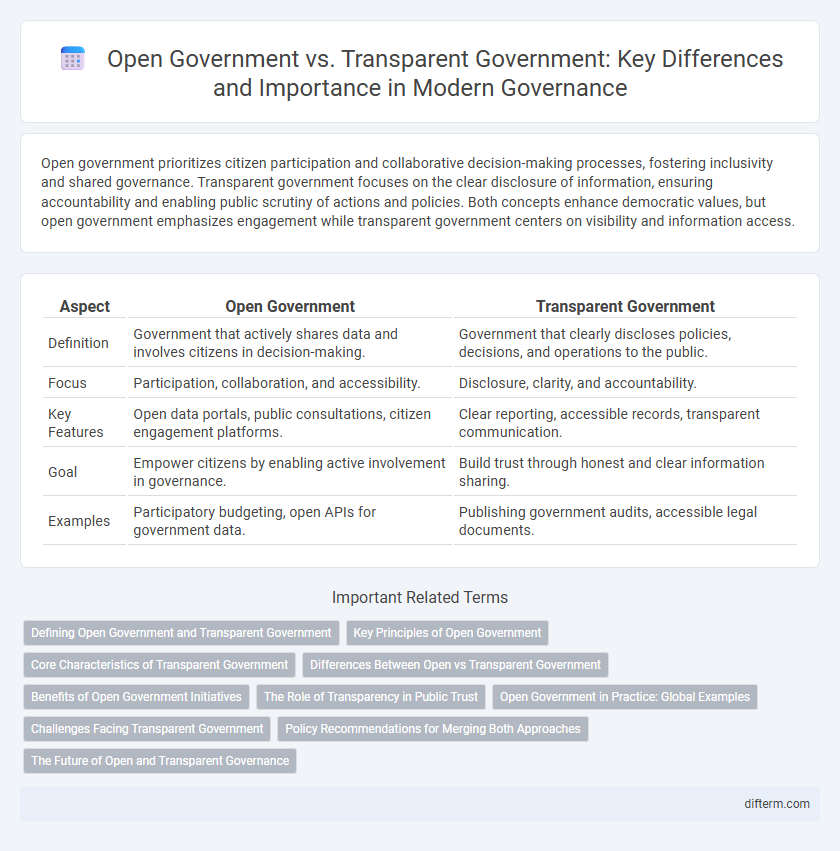Open government prioritizes citizen participation and collaborative decision-making processes, fostering inclusivity and shared governance. Transparent government focuses on the clear disclosure of information, ensuring accountability and enabling public scrutiny of actions and policies. Both concepts enhance democratic values, but open government emphasizes engagement while transparent government centers on visibility and information access.
Table of Comparison
| Aspect | Open Government | Transparent Government |
|---|---|---|
| Definition | Government that actively shares data and involves citizens in decision-making. | Government that clearly discloses policies, decisions, and operations to the public. |
| Focus | Participation, collaboration, and accessibility. | Disclosure, clarity, and accountability. |
| Key Features | Open data portals, public consultations, citizen engagement platforms. | Clear reporting, accessible records, transparent communication. |
| Goal | Empower citizens by enabling active involvement in governance. | Build trust through honest and clear information sharing. |
| Examples | Participatory budgeting, open APIs for government data. | Publishing government audits, accessible legal documents. |
Defining Open Government and Transparent Government
Open government refers to a framework where government activities, decisions, and data are accessible and participatory, promoting citizen engagement and collaboration in policymaking. Transparent government emphasizes clarity and openness in government operations, ensuring that information is readily available and understandable to the public to foster accountability. While open government prioritizes participatory decision-making and inclusivity, transparent government focuses on visibility and the clear communication of government actions and data.
Key Principles of Open Government
Key principles of open government include transparency, accountability, and public participation, which collectively enhance trust and democratic governance. Transparency ensures accessible information about government activities, while accountability requires officials to answer for decisions and policies. Public participation invites citizen engagement in decision-making processes, fostering inclusivity and responsiveness.
Core Characteristics of Transparent Government
Transparent government prioritizes openness, accountability, and accessibility in its operations, ensuring citizens have clear access to information and decision-making processes. Core characteristics include proactive disclosure of data, responsiveness to public inquiries, and the implementation of robust mechanisms for monitoring and reporting government activities. Transparency fosters trust and enhances civic engagement by enabling citizens to hold officials accountable and participate meaningfully in governance.
Differences Between Open vs Transparent Government
Open government emphasizes citizen participation and access to government processes, enabling public collaboration in decision-making and policy formation. Transparent government focuses on the clear disclosure of government activities, financial transactions, and policies to ensure accountability and build public trust. While transparency provides information flow, openness fosters active engagement and shared governance between the state and its citizens.
Benefits of Open Government Initiatives
Open government initiatives enhance public trust by promoting citizen participation, ensuring government accountability, and improving decision-making through the integration of diverse perspectives. Access to open data facilitates innovation, economic growth, and efficient public service delivery by enabling businesses, researchers, and civil society to leverage government information. Increased transparency reduces corruption risks, strengthens policy effectiveness, and fosters a collaborative environment where government operations become more responsive to societal needs.
The Role of Transparency in Public Trust
Transparency in government plays a critical role in building public trust by ensuring that citizens have access to clear and accurate information about decision-making processes and resource allocation. Open government fosters transparency by promoting accountability, enabling public participation, and reducing corruption risks through proactive disclosure of data and policies. Increased transparency directly correlates with higher levels of public confidence in governance institutions and policy outcomes.
Open Government in Practice: Global Examples
Open Government in practice demonstrates increased citizen participation through initiatives like Brazil's e-Democracia platform and Estonia's e-Residency program, which foster inclusive decision-making and digital access to public services. South Korea's Government 3.0 strategy emphasizes data sharing across agencies, enhancing accountability and service delivery in real-time. These global examples highlight how open government frameworks leverage technology to improve transparency, collaboration, and trust between governments and citizens.
Challenges Facing Transparent Government
Transparent government faces challenges such as balancing privacy concerns with public access to information and combating misinformation that undermines trust. Implementing effective transparency measures requires addressing bureaucratic resistance and ensuring technological infrastructure supports open data initiatives. Public engagement often falls short due to limited digital literacy and varying levels of citizen involvement.
Policy Recommendations for Merging Both Approaches
Effective policy recommendations for merging open government and transparent government emphasize enhancing citizen engagement through accessible digital platforms and real-time data disclosure. Establishing standardized frameworks for information sharing ensures accountability while promoting collaborative decision-making processes. Integrating these approaches fosters trust and improves governance outcomes by balancing openness with clear transparency protocols.
The Future of Open and Transparent Governance
Open government emphasizes citizen engagement, collaboration, and access to information, fostering participatory decision-making processes that strengthen democratic legitimacy. Transparent government prioritizes the clear disclosure of policies, data, and government activities to ensure accountability and build public trust. The future of governance integrates these principles through advanced digital platforms and real-time data sharing, enhancing responsiveness and empowering citizens with comprehensive insights into government operations.
open government vs transparent government Infographic

 difterm.com
difterm.com